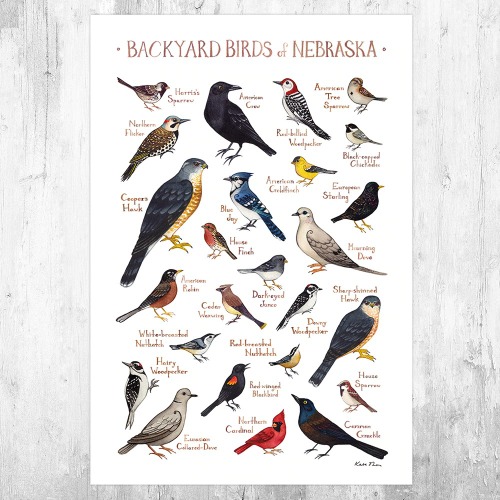Home to 466 bird species, Nebraska is heaven for birding enthusiasts!
Whether you are into wildlife photography or simply want to adorn flying creatures in their natural habitats, the Cornhusker State is a great destination. With the plethora of birds in the state, identifying them can be confusing. From their colors to feeding habits, they are different in many ways.
Curious about the birds that you will find in Nebraska? Read on as we walk you through some of the most popular species, including their notable characteristics.
30 Of The Most Popular Birds In Nebraska
Ready to expand your knowledge about birds? Here are the most common species that call Nebraska their home.
1. Northern Cardinal
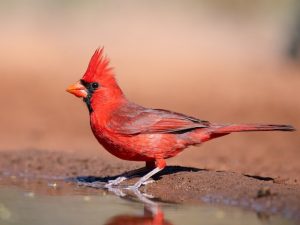
The vivid red color of the northern cardinal makes it one of the easiest to identify amongst the backyard birds in Nebraska.
A male northern cardinal has a bright red body with a black throat and face. On the other hand, a female northern cardinal has an olive to brown body with a hint of red in its wings. Meanwhile, immatures are brownish throughout the body with a dark-brown bill.
Northern cardinals are permanent residents in Nebraska, so you have a high chance of spotting them throughout the year. You will find them in forest openings and edges. They are also present in parks, especially those with low trees.
Even in backyards, northern cardinals are frequent visitors. The best way to attract them is to fill bird feeders with black oil sunflower seeds. Peanuts, corn, and safflower seeds are also good to have. Plus, it will help to have a birdbath with a freshwater supply.
Both male and female northern cardinals sing. Their song has a two-parted whistle, which speeds up and concludes with a slow trill.
2. American Robin
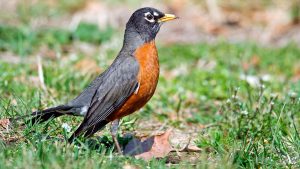
While it is gray-brown in its upper body, the lower body is colorful, making the American robin a beautiful bird. The breast is orange or red while the bill is yellow. The head and tail are black.
American robins are among the most popular backyard birds in Nebraska. You can find them throughout the year in the state, although they are most common during the breeding season.
One of the most common places where you can see an American robin is on the lawn where it is tugging earthworms. When it is not foraging on the ground, they will also be in shrubs and trees looking for berries to eat.
Aside from the backyards, they are also regular in mountains, fields, forests, woodlands, and parks.
Even if it has an abundant population in Nebraska, it is rare for American robins to visit bird feeders because they do not eat seeds.
3. Blue Jay
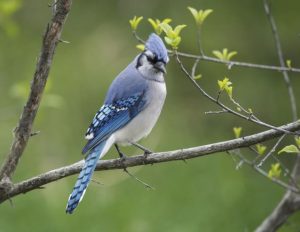
The bright blue color with black and white markings makes blue jays easily identifiable. Their size ranges from 10 to 12 inches while their wings extend from 13 to 17 inches.
Aside from being colorful, you can easily detect the presence of a blue jay because it is one of the birds in Nebraska. They can even imitate hawk calls!
Because they are year-round residents in Nebraska, it is easy to see a blue jay. While they are mainly forest dwellers, it is also common for them to be seen in backyard feeders.
If you want to attract blue jays in the backyard, then provide food for them, including peanuts, mixed seeds, black oil sunflower seeds, and suet.
Even if these birds are beautiful, some people consider them a nuisance. Aside from being noisy, they can also bully other smaller birds. While it is technically a songbird, its calls are obnoxious.
4. Dark-Eyed Junco
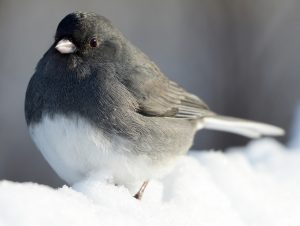
An adult dark-eyed junco has a gray upper body and white belly. The outer tail feathers are white, which are flashing in flight. The bill is pinkish. Males often have darker colors compared to females.
Dark-eyed juncos are winter birds in Nebraska. The best chance of seeing them in the state is from October to April.
They are also called snowbirds because they are often in Nebraska close to winter. As spring comes, however, they will migrate to other areas with a cooler climate.
Are you looking for dark-eyed juncos in Nebraska? Make sure to check out coniferous and mixed coniferous forests. They also like spending time in fields and parks.
Like most of the birds on this list, you can attract them to bird feeders, especially if you have an ample supply of sunflower seeds and dried berries.
5. Western Meadowlark
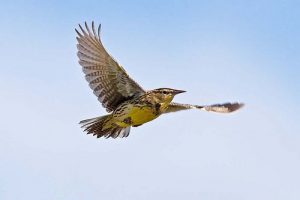
The Western meadowlark is the official state bird of Nebraska.
A part of the family of blackbirds, western meadowlarks have almost the same size as a robin. On average, the length is anywhere from 6.3 to 10.2 inches. Meanwhile, it can extend its wings at a width of 16.1 inches.
The colors of males and females are similar. They have a bright yellow breast with a black V-shaped band.
More than their appearance, recognizing these birds is also possible by listening to their song. They are flute-like, making them pleasant to the ears.
Western meadowlarks are available in Nebraska throughout the year but are most visible during the breeding season. Recent records show that they are more abundant in the summer compared to spring.
It is common to see western meadowlarks staying in flocks, especially in pastures, meadows, and grasslands where they eat insects.
6. House Sparrow
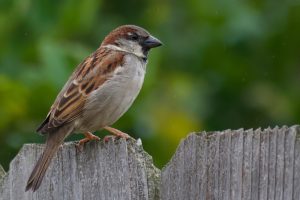
Originally from the Middle East, house sparrows are invasive species. Today, they are amongst the most common backyard birds in Nebraska and the world.
A male house sparrow has a black bib, gray crown, and white cheeks. It has chestnut sides on the neck and face. The back, on the other hand, is streaked brown and black.
Meanwhile, a female house sparrow is a dull brown with black streaks at the back. The lower body is light brown. One of the easiest ways to distinguish them from males is to look under the eyes where you will see a tan line.
Since house sparrows are non-migratory, you will see them in Nebraska throughout the year, whether it is summer or winter. Although, they tend to be more visible when it is cold.
They can adapt to different conditions, and hence, they can live even with humans. You can see house sparrows even in urban settings. They love grains and bread. Attract them to feeders by adding cracked corn and millet.
7. White-Breasted Nuthatch

A compact bird, one of the first things that you will notice in a white-breasted nuthatch is that it does not have a neck. The bill is pointy while the tail is short.
As for the colors, they have a white belly and face, black cap, and blue-gray back. If white-breasted nuthatches are in your birding itinerary, then your best bet of seeing them would be in deciduous forests.
Good thing, you do not need to go far for a personal encounter with white-breasted nuthatches. They are also frequent visitors of backyard bird feeders, especially when there are black oil sunflower seeds, corn, hawthorn, and acorn. Insects, such as beetles and caterpillars are also favorite foods.
If you are having a hard time seeing white-breasted nuthatches, then have an open ear. They are incredibly vocal and have a repetitive, distinctive noise.
8. Downy Woodpecker
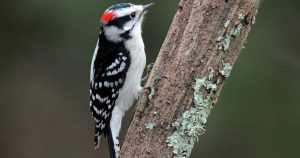
The downy woodpecker is the smallest woodpecker in North America. Because of its size, it can be difficult to identify from afar, so you might need to look closer.
One of the first things that you must look at in downy woodpeckers is the lower body, which should be all white. Meanwhile, the wings are black with white markings. At the back of its head, males will have red spots.
Woodlots, city parks, and backyards are some of the places where you will find downy woodpeckers. They will visit bird feeders with suet, black oil sunflower seeds, peanuts, and millet. Downy woodpeckers will also go to hummingbird feeders where they will drink sugar water.
A year-round resident, although most sightings are in the winter, the downy woodpecker is one of the most common backyard birds in Nebraska.
9. Black-Capped Chickadee
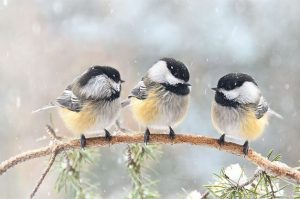
As it is named, the most prominent characteristic of this bird is its black cap. It also has a black triangular bib around its throat. The stomach is white while the tail is gray.
You will hear people calling the black-capped chickadee a cute bird. It has a large round head while the entire body is tiny.
Black-capped chickadees are inquisitive. They love investigating humans as well as their surroundings. Because they are frequently present, it is one of the first birds that you will see in Nebraska.
Getting a black-capped chickadee to visit your backyard is easy. With sunflower seeds, peanuts, and suet, it is almost guaranteed that they will make their way to your garden. If you want them to have nesting sites, on the other hand, you will need alder, birch, and willow.
In the wild, black-capped chickadees thrive in deciduous and mixed deciduous evergreen forests.
10. Red-Winged Blackbird
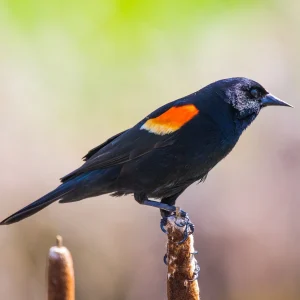
With its name, you might think that its wings are entirely red. Nonetheless, only a portion of it is red. Most of their wings are black with a reddish-orange patch.
Males and females are almost completely different in appearance. While males have mostly black plumage, females have brown bodies with light streaks.
The most common months when you can see red-winged blackbirds in the Cornhusker State would be from March to July. Even if they are in Nebraska in the winter, their sightings are rare.
In the breeding season, they are found in marshes and similar wet locations. Meanwhile, when it is a non-breeding season, look for them in pastures, farmlands, and grasslands. Most of the time, you will find red-winged blackbirds in large flocks. They are often with starlings, cowbirds, and grackles.
The rich and musical song of a red-winged blackbird will make it easy to note their presence. It sounds like conk-la-ree, which will last one second.
Lastly, a red-winged blackbird is polygynous. This means that one male can mate with up to 15 females.
11. Mourning Dove
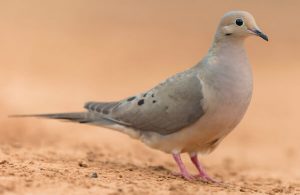
With its slender tail and small head, the mourning dove is one of the most graceful Nebraska birds. The tail is long while the body is plump.
At a length of 9 to 13 inches, the mourning dove is almost the same size as a robin. With its wings open, it can have a span of up to 17 inches.
Even in urban settings, mourning doves are a common sight. They like to spend their time on telephone wires. You can also find them on the ground, especially when they are foraging for seeds, which make up the majority of their diet.
Do you want to attract mourning doves to your backyard? You can do so by scattering cracked corn, millet, and sunflower seeds.
Mourning doves create a haunting and sad sound. In most cases, it is the male mourning dove that makes this sound. When you hear such, it is reminiscent of someone mourning, which is where they got their name.
12. Brown-Headed Cowbird
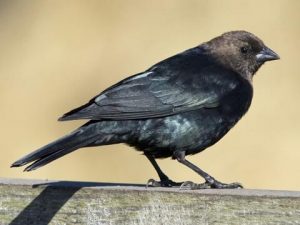
This stocky and chunky blackbird has varying colors depending on its gender. Males have a black body with a dark brown head. Meanwhile, females are plain brown throughout the body with streaks on their belly.
Some of the most common places where you can spot a brown-headed cowbird in the state are woodland edges, prairies, brushy thickets, and grasslands.
Nonetheless, they have expanded their habitats to include even locations surrounded by humans. It is not uncommon to see a brown-headed cowbird in cemeteries, orchards, and pastures.
The bird is also known for its habit of letting other birds build a nest for them. The female will deposit its egg on a nest built by other birds.
Ever wondered why it is called a cowbird? They follow cattle around as they search for insects to eat.
13. Red-Bellied Woodpecker
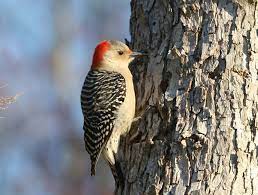
While it is called a red-bellied woodpecker, the red belly is not the first thing that you will notice in this bird. The color of the belly is paler than what you would expect. Its red streak at the back of its head is more visible than the color of the belly. It is complemented by its white beak and black and white wings.
A red-bellied woodpecker is known for having a powerful beak. This is what the bird uses to create circular holes in the woods.
You can see these woodpeckers almost daily in the backyard. No need to plan a birding trip if you want an up-close encounter. If they are not visiting your backyard, then there is probably something wrong with your feeder. Fill it with sunflower seeds, suet, and peanuts, and they will soon arrive.
14. Chipping Sparrow
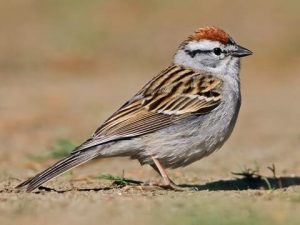
Chipping sparrows are small songbirds. The plumage is mostly brown and black with gray underparts. Males are slightly heavier and bigger while females have a wider wingspan and a larger belly.
A frequent visitor to bird feeders, they will eat seeds, nuts, and birds. You can also find them hunting for worms and larvae in the backyard.
The best time to see a chipping sparrow in Nebraska is in the summer, as well as in other parts of the United States. In the winter, they will fly to Mexico, with some of them spending their time in Florida.
As for the habitat, chipping sparrows thrive in open woodlands. They like coniferous and open forests. They are also common in suburban areas, including those with man-made landscapes.
15. House Wren
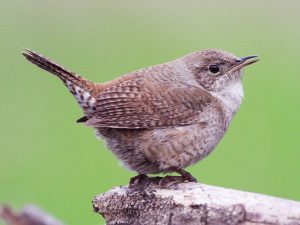
The house wren is a small and round bird. It has a thin bill and a short tail. Another physical feature is the dark barring on its tail and wings. Males and females have similar looks. They are not as colorful as other birds, so they can be easy to miss.
A good way to spot them is to listen to their sound, which is often a long and jumbled bubbling.
The best time to see a house wren in Nebraska is in the summer. They are most frequent from April to October. In the winter, they move south.
Some of the best places where you can look for house wrens are in open woods, parks, and backyards. It is seldom that they will visit a backyard feeder, but you can see them zipping around the garden as they hunt for insects.
A house wren will eat spiders and insects, including caterpillars, beetles, and flies. They will also feed on snails, which is their source of calcium.
16. European Starling
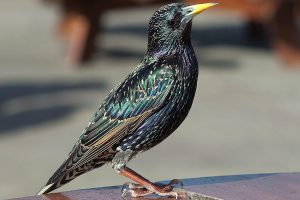
The European starling is one of the most common songbirds not only in Nebraska but in the United States. It is a stocky black bird with triangular wings, a pointed bill, and a short tail. When they are flying, they look sharp and pointed like a star, which is where it got its name.
When it is foraging, the European starling spends most of its time on the ground. It can also be up in a tree, especially when it is eating fruits straight from its source. They are usually in large flocks when they search for food.
The diet of European starlings is varied, depending on their location. Some of the insects that they will eat are grasshoppers, caterpillars, and flies. They also like snakes and spiders, as well as seeds and berries.
European starlings are invasive species. They are known for causing hundreds of millions in agricultural damage. Even in the backyard, they can be a nuisance.
Fun Fact: European starlings first appeared in North America in the 19th century when they were brought to the country by Shakespeare enthusiasts.
17. Northern Flicker
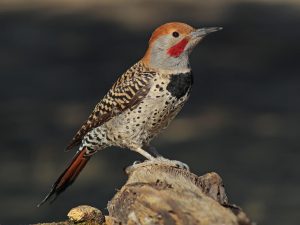
The northern flicker has a brown back with black barring. Under the body, the bird has black spots. It also has a black bib and white rump.
You can see two races of northern flickers in Nebraska. The first is yellow-shafted, which has a yellow lining in its wings. The second is red-shafted, which has a salmon pink lining in the wings.
The most common habitats for northern flickers are open woodlands, woodlots, orchards, and urban gardens. They tend to avoid dense forests.
A northern flicker has a curved bill, which it uses to dig on the ground to forage. Beetles, ants, seeds, and fruits constitute most of its diet. You can attract them to your backyard through a suet feeder.
Northern flickers are not territorial when they are hunting. They can be seen with other birds. However, they are defensive when it comes to their nesting sites.
18. House Finch
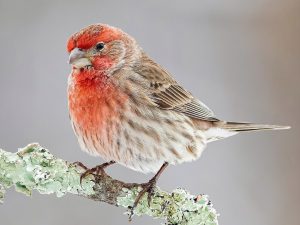
House finches are small birds, which are about the same size as dark-eyed juncos. It has a red breast and head while most of the body has brown streaks. You will see house finches in Nebraska year-round since they are non-migratory. They are more common in the winter compared to summer.
From farms to forest edges, parks to backyard feeders, they are almost everywhere in the state. Regardless, they will appear in noisy groups, so they are almost impossible to miss even if they are small. For their diet, house finches will eat seeds from small plants, small worms, berries, and insects.
One of the best ways to attract them to your yard is by installing a thistle feeder.
19. Summer Tanager
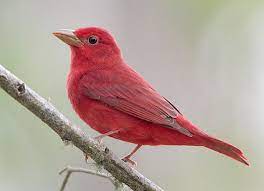
With its colors, it is almost impossible to miss a summer tanager when you see one. Males are deep red throughout the body. The wings are medium length while the tail is long and rounded.
Meanwhile, females are bright yellow on the head with a concentration of green on their wings. This beautiful bird is a frequent visitor in the southeastern parts of Nebraska. They are often present from May to October.
Aside from the right timing, the secret to seeing these birds in the state is to scout in the right locations. They prefer bottomland and deciduous forests. They have a high population in areas with tall oak trees.
The summer tanager is known for being a bee and wasp specialist. They can catch them even mid-flight and can get rid of the stinger by rubbing in a tree.
Aside from bees, the diet of summer tanagers also includes fruits and berries.
20. Barn Swallow

A stocky Nebraska bird with a short neck, one of the most noticeable in a barn swallow is its deep blue back. The throat is rusty orange while the head is pale orange. Males and females look almost alike, with the main difference being the females having a less forked tail.
Barn swallows are in Nebraska and the United States during the breeding season, which is in the spring and summer. Come winter, they will fly to Central and South America.
Do not expect barn swallows to come to bird feeders. If you want them on your property, you might have some luck by building a nest box.
They will feed on a wide variety of flying insects. Their food can also include bees, wasps, winged ants, true bugs, and beetles.
21. Orchard Oriole
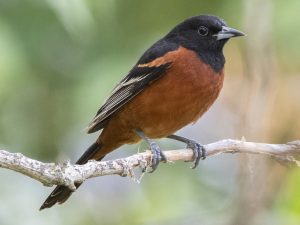
One of the colorful birds that you will find in Nebraska, the orchard oriole is a visual treat. Males are dark range while females are yellow-green.
It is common to see orchard orioles in Nebraska in the summer. In the winter, they will migrate to Mexico. Nonetheless, sightings are unusual since they love spending their time on treetops.
Even so, you can still see them in the backyard, especially when you have mulberries or shrubby vegetation. They can also come to a nectar feeder with sugar water. If you want to see an orchard oriole, some of the natural habitats worth checking out are open woodlands, scrublands, farms, lakeshores, swamps, and rivers.
The orchard oriole is also known for making a bubbly song. It has sweet, lyrical, and delicate sounds.
22. Song Sparrow
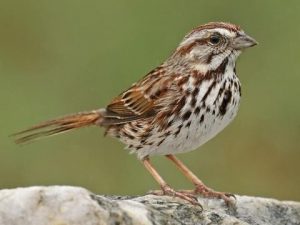
Compared to other birds on this list, song sparrows are not as remarkable. Its body has predominantly brown streaks. The head, meanwhile, has a brown cap and a gray stripe.
While most birds will nest in trees, a song sparrow is different. The most common nesting sites are grasses and weeds. You will also find them nesting on the ground.
If there is one thing that most people love in a song sparrow, it is its song. The name itself is already a giveaway. It starts with three short notes and ends with a trill. Although, its call can vary depending on the location.
Song sparrows are in eastern Nebraska throughout the year. In the western part of the state, however, they are only winter birds.
23. Hairy Woodpecker

Hairy and downy woodpeckers have an almost similar appearance, making it challenging to differentiate one from the other. The main difference is that the hairy woodpecker is larger.
As it is with the other parts of the United States, this woodpecker is a year-round resident in Nebraska. You can find them even in backyard feeders.
The majority of its diet is insects. It feeds on wood-boring beetles, ants, and caterpillars. It will also eat some types of nuts, berries, and seeds. They also like sap on damaged trees.
It is energetic when searching for food. It scrapes bark and excavates dead wood as it looks for insects to eat.
The habitat is varied, mostly in areas with lots of trees. They also prefer mixed and coniferous forests, swamps, and open juniper woodlands.
24. American Crow
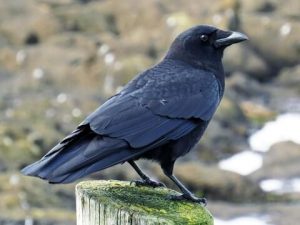
The American crow is a large bird with black wings, legs, feet, and bill. It also has an iridescent sheen, which is especially visible when in a well-lit environment.
Being adaptable birds, you can see American crows in many locations, including parks, landfills, marshes, rivers, golf courses, fields, and woodlands.
Unlike other backyard birds, they won’t often come to bird feeders. Nonetheless, there is a chance that you can attract them if you provide foods like whole kernel corn and suet. They will also eat large insects and small mammals.
American crows are known for being amongst the smartest birds. They can recognize human faces!
They are also known for gathering in massive flocks, especially during the winter. You can easily spot them because of their sound, which is a series of loud caws.
25. Eastern Kingbird
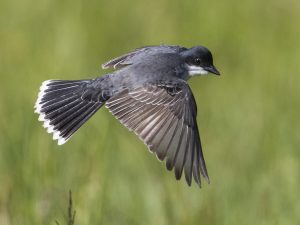
Male and female eastern kingbirds look alike. They have a slate-gray back, black head, white underparts, and black tail. It also has an orange-red patch on its crown, but it isn’t always visible.
When searching for an Eastern kingbird, look for them in open areas with tall shrubs or scattered trees. They also often forage at intersections and trees. These birds often perch on telephone lines and streetlights.
It is a regular breeder in Nebraska. Your best chances of seeing them are in the summer as they migrate in the spring and fall.
Eastern kingbirds are territorial and feisty. They will attack nest predators and bigger birds, including crows and hawks, which is a common behavior among kingbirds.
26. Baltimore Oriole
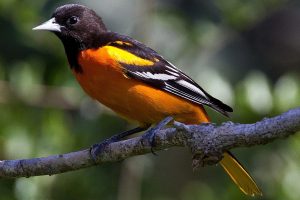
The appearance of Baltimore orioles in Nebraska is a sign of spring. Their vivid colors are sure to add beauty to the season. Males have a brilliant yellow underbody, which stands out because of their black wings. It also has two white wing bars, which are not present in females.
It is only during the breeding season that you will see Baltimore orioles in Nebraska.
This is from mid-April to September, a time when they are believed to be up to 32% of the birds seen in the state. Timing is not the only thing that matters if you want to see Baltimore orioles. You must be at the right place at the right time.
These birds frequent riverbanks, forest edges, and open woodlands. They can also go to backyards and parks.
Like many of the other birds on this list, the diet of a Baltimore oriole is mostly insects, such as grasshoppers, crickets, and beetles. They can also eat pests, making them a good sight in the garden.
27. Yellow Warbler
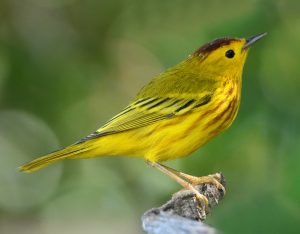
It is almost impossible to not notice a yellow warbler when you see one. At approximately five inches, it might be small, but the bright yellow body makes it unmistakable. Aside from the color of its body, other physical identifiers of a yellow warbler are its yellow markings on the tail and wings. It also has a yellowish-olive back and dark eyes.
The most common places where you can see yellow warblers are on the top of small trees and tall shrubs. You can also see these birds foraging restlessly. They will quickly hop on twigs and branches when searching for food.
Speaking of food, it will eat insects most of the time, especially caterpillars. It can also feast on beetles, mosquitoes, moths, treehoppers, and mayflies. Spiders and berries are also regular foods.
Yellow warblers are in Nebraska from April to October. This is where they spend their breeding season.
28. Red-Headed Woodpecker
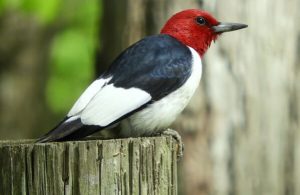
A medium-sized bird, the red-headed woodpecker has a spike-like bill, stiff tail, and round head. On average, its length is 7.5 to 9.1 inches with its wings extending at a width of up to 16.5 inches.
Adult red-headed woodpeckers have bright red heads. The underparts are white and the back is black with white patches on its wings. With such a coloration, the back looks as if it is all white when the bird is perched.
One of the most common behaviors of this bird is that it hammers wood to catch insects, which is normal in woodpeckers. It can also hunt insects while it is on the ground and even when it is flying.
Looking for red-headed woodpeckers? Their most popular habitats are open forests, pine savannahs, wetlands, and agricultural areas.
29. Cliff Swallow
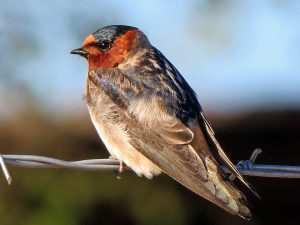
You can recognize a cliff swallow through its dark blue back. Plus, it has long and dark brown wings with a hint of black around its shoulders. The name is already a clue about the habitat of a cliff swallow. It spends most of its time on cliffs, as well as other high locations like bridges.
Many of them also love the water, so it is unusual to find cliff swallows next to streams and ponds.
While it is possible to see this bird in your backyard, they are not fans of bird feeders. They prefer catching insects while they are flying. If you want to try your luck, you might want to try putting black oil sunflower seeds or live mealworms in your yard.
While it is common for a cliff swallow to nest solitarily, they can also build nests as a colony. At times, they can build up to 3,700 nests in a single location!
30. Western Kingbird
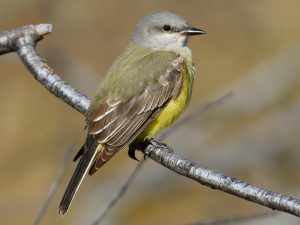
With its eye-catching colors, the western kingbird is one of the best subjects for bird photography in Nebraska. It has a lemon-yellow plumage that you are sure to find attractive.
You do not need to go far if you want to see a western kingbird in Nebraska. You can find them on roadside wires, utility poles, and fences. Other places where you can see western kingbirds are in agricultural croplands, riparian woodlands, and dry savannahs.
In most instances, western kingbirds are solitary creatures. In the winter, it is also possible to find them flying in small pairs.
Despite its size of eight to nine inches, the Western Kingbird is known for its aggressive behavior and will attack avian predators including owls, crows, and hawks!
Watch This!
Frequently Asked Questions
What birds stay in Nebraska during the winter?
While many of the birds in Nebraska are residents, there are also seasonal ones, including those that are present only in the winter. Some of these birds are the black-capped chickadee, American tree sparrow, red-breasted nuthatch, blue jay, and dark-eyed junco.
How do I attract birds in Nebraska?
To attract birds in Nebraska, you will need to create an ideal environment. Bird feeding is a great way to make them come to your backyard and observe up close. To do this, you must provide their three basic needs – food, water, and cover. A bird feeder is a must-have, which should contain seeds, nuts, and berries, among others.
Are there finches in Nebraska?
Yes, there are finches in Nebraska. Some of the most popular finches in the state are house finches, American finches, purple finches, and lesser goldfinches. Many of them are regularly occurring in the state while others are accidental species.
Conclusion
Tallgrass prairies, riparian areas, and wetlands – are just some of the diverse landscapes in Nebraska that make the state a great habitat for diverse birds. From tiny finches to mighty hawks, it has a long list of flying creatures adorning its skies and visiting even private backyards.
Are there other birds in the state that you would like to add to this list? Write a comment below and share your thoughts.

